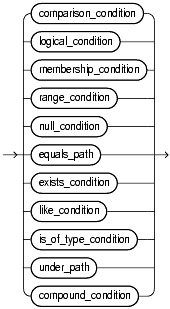| Oracle9i SQL Reference Release 2 (9.2) Part Number A96540-02 |
|
|
View PDF |
| Oracle9i SQL Reference Release 2 (9.2) Part Number A96540-02 |
|
|
View PDF |
Conditions can have several forms, as shown in the following syntax.
condition::=

|
Note: If you have installed Oracle Text, then you can use the built-in conditions that are part of that product, including |
The sections that follow describe the various forms of conditions. You must use appropriate condition syntax whenever condition appears in SQL statements.
You can use a condition in the WHERE clause of these statements:
You can use a condition in any of these clauses of the SELECT statement:
A condition could be said to be of the "logical" datatype, although Oracle does not formally support such a datatype.
The following simple condition always evaluates to TRUE:
1 = 1
The following more complex condition adds the sal value to the comm value (substituting the value 0 for null) and determines whether the sum is greater than the number constant 2500:
NVL(salary, 0) + NVL(salary + (salary*commission_pct, 0) > 25000)
Logical conditions can combine multiple conditions into a single condition. For example, you can use the AND condition to combine two conditions:
(1 = 1) AND (5 < 7)
Here are some valid conditions:
name = 'SMITH' employees.department_id = departments.department_id hire_date > '01-JAN-88' job_id IN ('SA_MAN', 'SA_REP') salary BETWEEN 5000 AND 10000 commission_pct IS NULL AND salary = 2100
| See Also:
The description of each statement in Chapter 9 through Chapter 18 for the restrictions on the conditions in that statement |
Precedence is the order in which Oracle evaluates different conditions in the same expression. When evaluating an expression containing multiple conditions, Oracle evaluates conditions with higher precedence before evaluating those with lower precedence. Oracle evaluates conditions with equal precedence from left to right within an expression.
Table 5-1 lists the levels of precedence among SQL condition from high to low. Conditions listed on the same line have the same precedence. As the table indicates, Oracle evaluates operators before conditions.